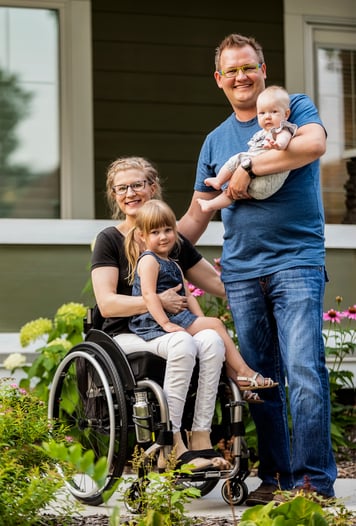Autonomic Dysreflexia in Pregnancy / Labor
] If you are pregnant or planning to be pregnant with autonomic dysreflexia (AD), you will have many questions about how AD affects your pregnancy. You already know that AD can be serious – even life-threatening – and you need to be prepared and be ready.
If you are pregnant or planning to be pregnant with autonomic dysreflexia (AD), you will have many questions about how AD affects your pregnancy. You already know that AD can be serious – even life-threatening – and you need to be prepared and be ready.
Some things to know: AD with severe high blood pressure (BP) is more dangerous during pregnancy than when you are not pregnant. Serious BP complications increase the risk of stroke, heart attack, obstetrical emergencies, and stillbirth. BP complications can happen at lower BPs than when you are not pregnant. Because of this, BP management is even more important during pregnancy than usual. Also, you may have ‘new’ triggers for your AD, and your AD symptoms may be different than what you are used to having.
If your AD symptoms are minor, you can probably be managed by your obstetrics provider with assistance from an anesthesiologist during labor and delivery. An example of a minor AD symptom is simple goose flesh relieved by positioning. If AD symptoms are more severe or worsen during pregnancy or develop during labor and delivery, then more providers and consultations may be needed to keep you and your baby safe.
AD triggers that may be more common in pregnancy include nausea/vomiting (morning sickness), dehydration, urinary bladder irritants (full bladder, urinary tract infection, catheterization), constipation, hemorrhoids, irritated skin/pressure sores, and tight clothing. Unfamiliar, new AD triggers may include fetal movements (yep, anytime the baby moves), uterine contractions (even Braxton-Hicks contractions), labor, and postpartum recovery.
The initial treatment for AD is to remove the offending stimulus. You should hydrate, treat vomiting, slowly drain your bladder (250 mL every 10-15 min), sit up / change positions, and remove tight clothing. You probably cannot prevent fetal movements or contractions, but sometimes hydration may reduce contractions, if you are not in labor. Medical treatment of high BP (> 160 / 110 mmHg) is appropriate in pregnancy, and your doctor(s) may prescribe short-acting medication to help with high (or low) BPs.
Sometimes home remedies are not enough and expert help is needed. For those with symptomatic AD, consultation with maternal-fetal medicine and anesthesia specialists may be useful. As a matter of fact, spinal/epidural anesthesia is highly effective and often advised to prevent and treat AD during pregnancy, labor and delivery. Sometimes care in a critical care unit is needed. During pregnancy, your medical team may grow to include urologists, spinal rehab physicians, physical and occupational therapists, nurses, lactation consultants, and other experts.
Remember: High BP in pregnancy can be very dangerous and life-threatening. Medications to help with BP can be taken at home or given in the clinic/hospital setting. Appropriately chosen medications that are efficacious (effective) are always safer for you than uncontrolled blood pressure that leads to a heart attack, a stroke, or worse. Even if you don’t like to take medications during pregnancy, taking BP meds when needed may need to be an exception to that rule.
The Reeve Foundation has a great, high-quality online resource for AD and spinal cord injury (SCI) (1). Most OB/GYNs and obstetrical providers in the United States will follow guidance from The American College of Obstetricians and Gynecologists (ACOG), Committee Opinion No. 808 (May 2020), “Obstetric Management of Patients with Spinal Cord Injuries”(2).
Each person’s pregnancy with AD is unique. Educational resources and online advice can be helpful, but this should not replace the advice of your personal doctor or other health care providers.
Dr. Robert Fuller is a board-certified Maternal-Fetal Medicine subspecialist practicing medicine and training medical professionals as an Associate Professor at the University of Virginia. His clinical interests include the management of complex, high-risk maternal conditions and complications of pregnancy. He lives in Keswick, VA, has been married 31 years and has six children, two dogs, a cat, a small tractor, and a henhouse full of chickens.
References:
Join Our Movement
What started as an idea has become a national movement. With your support, we can influence policy and inspire lasting change.
Become an Advocate